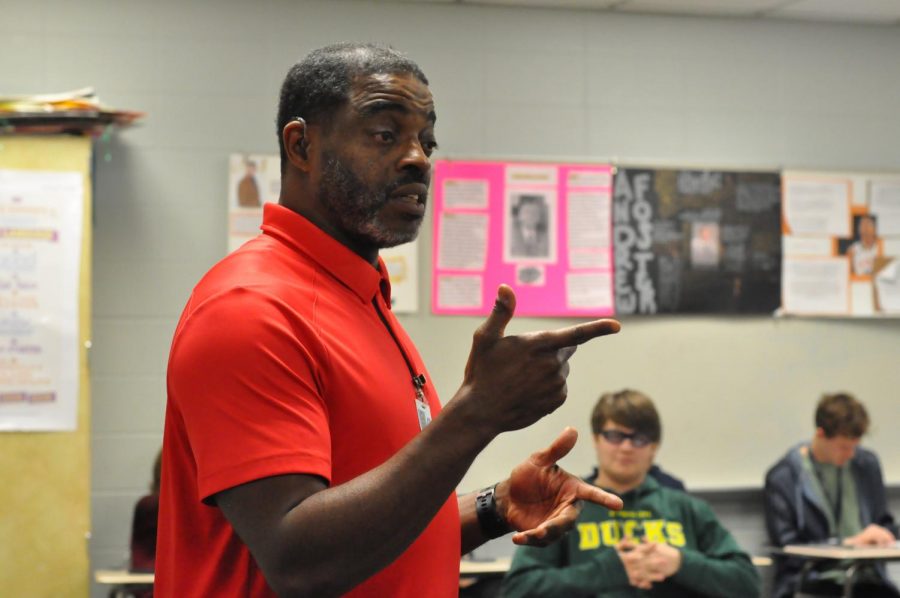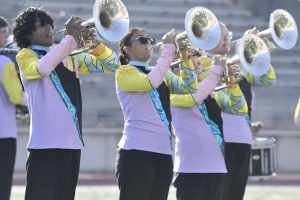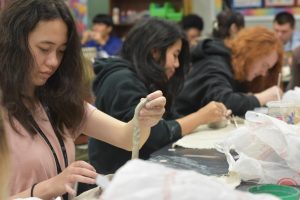Woods’ many lessons include acceptance
Woods learned sign language in college, and has found his passion in teaching it at the high school level.
American Sign Language teacher Darnell Woods communicates with students in his fifth period class on March 22. Woods’ mom first noticed he was hard of hearing when he was 5 years old. He has worn hearing aids since third grade, but his hearing has progressively worsened over time.
March 28, 2019
Darnell Woods was only 5 years old when he began turning the television up as loud as he could. As soon as his mother noticed, she knew he was hard of hearing. She was not surprised. She was deaf and so was her mother. Three of Woods’ uncles were also deaf.
By third grade, he was wearing hearing aids and attending speech classes.
His mom never allowed him to use his hearing loss as a hindrance. Woods was in all regular classes in school. Other than having to sit in front of the class, he was taught just like everyone else.
“My mom is probably the hardest working person I’ve ever met,” Woods said. “She has an eighth grade education; but with me and my siblings, she pushed us to go get our education at the highest level.”
Woods did just that. He got his Bachelor’s degree from Gallaudet University in English and his Masters degree from Lamar University in deaf studies. He also played football and basketball at Gallaudet, a private university for the education of the deaf and hard of hearing in Washington, D.C.
Now, the father of six teaches American Sign Language, hoping to spread the language and inspire acceptance of others at Kingwood Park.
“ASL is such a unique language people of all ages can learn and utilize in their everyday lives,” Woods said. “It’s a language that can capture the imagination if you take advantage of all it has to offer.”
Woods wasn’t exposed to American Sign Language until his freshman year at Gallaudet. His family relied entirely on hearing aids while he grew up in Washington, D.C. Learning sign language proved to be very helpful as his hearing continued to deteriorate.
“I’m resigned to the fact that one day I will lose what residual hearing I have left,” Woods said. “My mother just lost hers not too long ago, and she just had surgery for a cochlear implant. For her I understand the decision to do it. Her primary language is spoken English. As for me, I have the sign abilities and am able to live without it.
“On the other hand, I’d miss listening to music and dancing in the car daily as I drive.”
Of Woods’ six kids, only the two oldest are hard of hearing. Woods’ wife Ashley Greene is also deaf. She is a deaf education teacher at Atascocita High School. She lost her hearing at age 3 after contracting bacterial meningitis.
“We’re louder,” Greene said. “Other than that, nothing’s different. Just like hearing parents, we get on the kids to do their homework and get off their phones. We go on vacations, we do everything a hearing family does.”
There are everyday challenges, though. Woods must be constantly aware of what is happening so he does not miss emergency situations, like fire alarms. Sign language interpreters and closed captioning are utilized during some faculty meetings.
On a day-to-day basis, he is on his own though, which is one reason he hopes his students can continue on to help deaf people who may need it.
“It’s a language that can be used even later in life,” Woods said. “I always tell my students that at some point they will run into or meet a deaf person. Anywhere. It could be at the store, a restaurant, something. They may be at a point where they need to sign. What little skills they may have from taking ASL in high school, it may be an opportunity to use it.”
His main lesson is acceptance. He is automatically thought of as different, especially in a hearing environment. He wants his students to be prepared to meet a deaf person and be accepting of all people.
“I want you to be accepting of me; and, then vice versa, I’m going to be accepting of you too,” Woods said.









Christine • Mar 30, 2019 at 2:52 pm
This is a great article of overcoming odds and becoming the change you know the world needs! ASL should be taught in all schools, allowing students to learn acceptance and a valuable life skill at the same time.